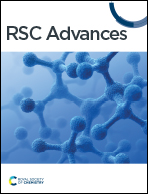A highly sensitive triazole-based perfectly water soluble novel bis-Schiff base reversible fluorescent-colorimetric chemosensor for fast detection of Pb2+ ions†
Abstract
A reversible fluorescent-colorimetric azino bis-Schiff base receptor for the detection of Pb2+ in aqueous medium has been developed for the first time. Receptor L exhibits an excellent selective and rapid fluorescent-colorimetric response towards Pb2+. The sensitivity of the fluorescent-based assay (0.53 nM) and colorimetric assay (1.0 nM) for Pb2+ is sufficiently good in comparison to previously reported literature. From 1H NMR data, Job plot measurement and the ESI-MS spectrum, a 1 : 2 stoichiometric complexation between L and Pb2+ has been established. Receptor L shows a remarkable detection ability in a wide pH range of 4–8 and it has been successfully utilised in the determination of Pb2+ in aqueous solution of bovine serum albumin protein and in real samples. The geometry of L has been optimized by both DFT studies and NMR, FTIR and mass spectra. Moreover, we have studied molecular docking of the probe L.



 Please wait while we load your content...
Please wait while we load your content...